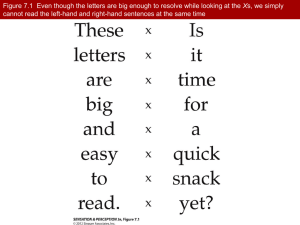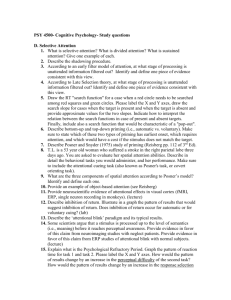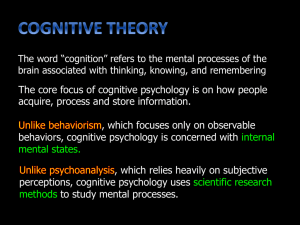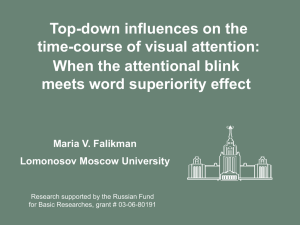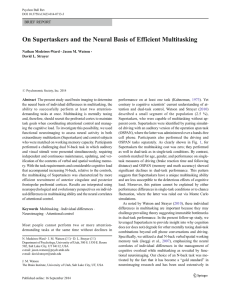Ling2Spr09
advertisement
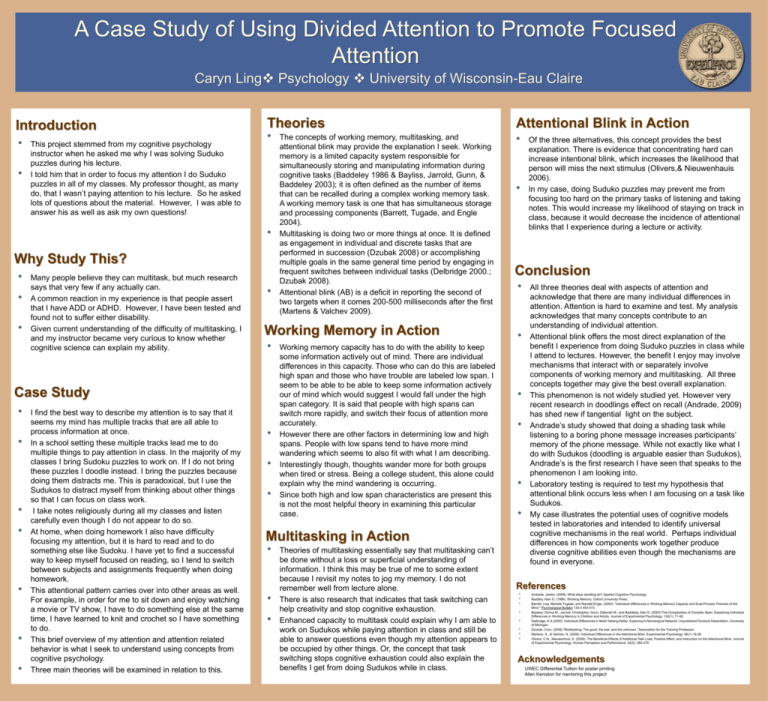
A Case Study of Using Divided Attention to Promote Focused Attention Caryn Ling Psychology University of Wisconsin-Eau Claire Introduction • • This project stemmed from my cognitive psychology instructor when he asked me why I was solving Suduko puzzles during his lecture. I told him that in order to focus my attention I do Suduko puzzles in all of my classes. My professor thought, as many do, that I wasn’t paying attention to his lecture. So he asked lots of questions about the material. However, I was able to answer his as well as ask my own questions! Theories • • Why Study This? • • • Many people believe they can multitask, but much research says that very few if any actually can. A common reaction in my experience is that people assert that I have ADD or ADHD. However, I have been tested and found not to suffer either disability. Given current understanding of the difficulty of multitasking, I and my instructor became very curious to know whether cognitive science can explain my ability. • Working Memory in Action • Case Study • • • • • • • I find the best way to describe my attention is to say that it seems my mind has multiple tracks that are all able to process information at once. In a school setting these multiple tracks lead me to do multiple things to pay attention in class. In the majority of my classes I bring Sudoku puzzles to work on. If I do not bring these puzzles I doodle instead. I bring the puzzles because doing them distracts me. This is paradoxical, but I use the Sudukos to distract myself from thinking about other things so that I can focus on class work. I take notes religiously during all my classes and listen carefully even though I do not appear to do so. At home, when doing homework I also have difficulty focusing my attention, but it is hard to read and to do something else like Sudoku. I have yet to find a successful way to keep myself focused on reading, so I tend to switch between subjects and assignments frequently when doing homework. This attentional pattern carries over into other areas as well. For example, in order for me to sit down and enjoy watching a movie or TV show, I have to do something else at the same time, I have learned to knit and crochet so I have something to do. This brief overview of my attention and attention related behavior is what I seek to understand using concepts from cognitive psychology. Three main theories will be examined in relation to this. The concepts of working memory, multitasking, and attentional blink may provide the explanation I seek. Working memory is a limited capacity system responsible for simultaneously storing and manipulating information during cognitive tasks (Baddeley 1986 & Bayliss, Jarrold, Gunn, & Baddeley 2003); it is often defined as the number of items that can be recalled during a complex working memory task. A working memory task is one that has simultaneous storage and processing components (Barrett, Tugade, and Engle 2004). Multitasking is doing two or more things at once. It is defined as engagement in individual and discrete tasks that are performed in succession (Dzubak 2008) or accomplishing multiple goals in the same general time period by engaging in frequent switches between individual tasks (Delbridge 2000.; Dzubak 2008). Attentional blink (AB) is a deficit in reporting the second of two targets when it comes 200-500 milliseconds after the first (Martens & Valchev 2009). • • • Working memory capacity has to do with the ability to keep some information actively out of mind. There are individual differences in this capacity. Those who can do this are labeled high span and those who have trouble are labeled low span. I seem to be able to be able to keep some information actively our of mind which would suggest I would fall under the high span category. It is said that people with high spans can switch more rapidly, and switch their focus of attention more accurately. However there are other factors in determining low and high spans. People with low spans tend to have more mind wandering which seems to also fit with what I am describing. Interestingly though, thoughts wander more for both groups when tired or stress. Being a college student, this alone could explain why the mind wandering is occurring. Since both high and low span characteristics are present this is not the most helpful theory in examining this particular case. Attentional Blink in Action • • Conclusion • • • • • • Multitasking in Action • • • Theories of multitasking essentially say that multitasking can’t be done without a loss or superficial understanding of information. I think this may be true of me to some extent because I revisit my notes to jog my memory. I do not remember well from lecture alone. There is also research that indicates that task switching can help creativity and stop cognitive exhaustion. Enhanced capacity to multitask could explain why I am able to work on Sudukos while paying attention in class and still be able to answer questions even though my attention appears to be occupied by other things. Or, the concept that task switching stops cognitive exhaustion could also explain the benefits I get from doing Sudukos while in class. Of the three alternatives, this concept provides the best explanation. There is evidence that concentrating hard can increase intentional blink, which increases the likelihood that person will miss the next stimulus (Olivers,& Nieuwenhauis 2006). In my case, doing Suduko puzzles may prevent me from focusing too hard on the primary tasks of listening and taking notes. This would increase my likelihood of staying on track in class, because it would decrease the incidence of attentional blinks that I experience during a lecture or activity. All three theories deal with aspects of attention and acknowledge that there are many individual differences in attention. Attention is hard to examine and test. My analysis acknowledges that many concepts contribute to an understanding of individual attention. Attentional blink offers the most direct explanation of the benefit I experience from doing Suduko puzzles in class while I attend to lectures. However, the benefit I enjoy may involve mechanisms that interact with or separately involve components of working memory and multitasking. All three concepts together may give the best overall explanation. This phenomenon is not widely studied yet. However very recent research in doodlings effect on recall (Andrade, 2009) has shed new if tangential light on the subject. Andrade’s study showed that doing a shading task while listening to a boring phone message increases participants’ memory of the phone message. While not exactly like what I do with Sudukos (doodling is arguable easier than Sudukos), Andrade’s is the first research I have seen that speaks to the phenomenon I am looking into. Laboratory testing is required to test my hypothesis that attentional blink occurs less when I am focusing on a task like Sudukos. My case illustrates the potential uses of cognitive models tested in laboratories and intended to identify universal cognitive mechanisms in the real world. Perhaps individual differences in how components work together produce diverse cognitive abilities even though the mechanisms are found in everyone. References • • • • • • • • Andrade, Jackie. (2009). What does doodling do? Applied Cognitive Psychology. Baddley, Alan D. (1986). Working Memory. Oxford University Press. Barrett, Lisa, Michele Tugade, and Randall Engle. (2004): "Individual differences in Working Memory Capacity and Dual-Process Theories of the Mind." Psychological Bulletin 130.4 553-573. Bayless, Donna M., Jarrold, Christopher, Gunn, Deborah M., and Baddeley, Alan D. (2003) The Complexities of Complex Span: Explaining Individual Differences in Working Memory in Children and Adults. Journal of Experimental Psychology, 132(1), 71-92. Delbridge, K.A (2000). Individual Differences in Multi-Tasking Ability: Exploring A Nomological Network; Unpublished Doctoral Dissertation, University of Michigan. Dzubak, Cora. (2008) "Multitasking: The good, the bad, and the unknown." Association for the Tutoring Profession Martens, S., & Valchev, N. (2009). Individual Differences in the Attentional Blink. Experimental Psychology. 56(1) 18-26 Olivers, C.N., Nieuwenhuis, S. (2006). The Beneficial Effects of Additional Task Load, Positive Affect, and Instruction on the Attentional Blink. Journal of Experimental Psychology: Human Perception and Performance. 32(2): 364-379 Acknowledgements UWEC Differential Tuition for poster printing Allen Keniston for mentoring this project
